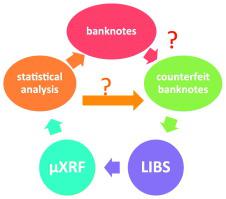当前位置:
X-MOL 学术
›
Spectrochim. Acta B. At. Spectrosc.
›
论文详情
Our official English website, www.x-mol.net, welcomes your feedback! (Note: you will need to create a separate account there.)
Characterization of the elemental composition of polish banknotes by X-ray fluorescence and laser-induced breakdown spectroscopy
Spectrochimica Acta Part B: Atomic Spectroscopy ( IF 3.3 ) Pub Date : 2020-07-01 , DOI: 10.1016/j.sab.2020.105898 Małgorzata Król , Klaudia Gondko , Agnieszka Kula , Patryk Własiuk , Julio M. del Hoyo-Meléndez , Paweł Kościelniak
Spectrochimica Acta Part B: Atomic Spectroscopy ( IF 3.3 ) Pub Date : 2020-07-01 , DOI: 10.1016/j.sab.2020.105898 Małgorzata Król , Klaudia Gondko , Agnieszka Kula , Patryk Własiuk , Julio M. del Hoyo-Meléndez , Paweł Kościelniak

|
Abstract In this study, two very promising techniques, micro X-ray fluorescence (μXRF) and laser-induced breakdown spectroscopy (LIBS) were applied to the examination of Polish banknotes – Polish zloty (zl). Several areas on each banknote were selected and analysed. Different elemental compositions were identified after comparing the spectra recorded from various measurement locations. It was possible to identify characteristic atomic emissions from one or several elements such as Ca, Ti, Fe, Ba, Co, Cr, Cu, Mg, Mn, Ni, V, and Zr, depending on the banknote denomination, issue date, and evaluated spot. Potentially good discriminators with unique elemental composition were identified: black serial number (C) and microlettering (A). A comparison of brand-new banknotes with used banknotes (which have been in circulation) was also performed. The middle horizontal section of the banknotes shows higher exposure to contamination and consequently constitutes the most difficult part to analyse. Counterfeit banknotes were also analysed and were clearly distinguished from authentic notes in all cases. It was demonstrated that a comparison of the elemental composition is a useful way to detect counterfeit banknotes (10, 20, 50 and 100 zl) in ‘real-world’ cases. This study shows the potential of LIBS and μXRF as effective and practical techniques to analyse Polish banknotes. Their many advantages provide a good alternative to the analytical methods routinely used for the examination of these objects.
中文翻译:

通过 X 射线荧光和激光诱导击穿光谱表征波兰纸币的元素组成
摘要 在这项研究中,两种非常有前途的技术,微 X 射线荧光 (μXRF) 和激光诱导击穿光谱 (LIBS) 被应用于检查波兰钞票——波兰兹罗提 (zl)。选择并分析了每张钞票上的几个区域。在比较从不同测量位置记录的光谱后,确定了不同的元素组成。根据钞票面额、发行日期和发行日期,可以识别一种或多种元素的特征原子发射,例如 Ca、Ti、Fe、Ba、Co、Cr、Cu、Mg、Mn、Ni、V 和 Zr评估点。确定了具有独特元素组成的潜在良好鉴别器:黑色序列号 (C) 和微字母 (A)。还进行了全新钞票与旧钞票(已流通)的比较。钞票的中间水平部分显示出较高的污染风险,因此构成了最难分析的部分。还对假钞进行了分析,并在所有情况下与真钞清楚地区分。事实证明,元素组成的比较是在“真实世界”案例中检测假钞(10、20、50 和 100 zl)的有用方法。这项研究显示了 LIBS 和 μXRF 作为分析波兰纸币的有效和实用技术的潜力。它们的许多优点为常规用于检查这些物体的分析方法提供了一个很好的替代方案。还对假钞进行了分析,并在所有情况下与真钞清楚地区分。事实证明,元素组成的比较是在“真实世界”案例中检测假钞(10、20、50 和 100 zl)的有用方法。这项研究显示了 LIBS 和 μXRF 作为分析波兰纸币的有效和实用技术的潜力。它们的许多优点为常规用于检查这些物体的分析方法提供了一个很好的替代方案。还对假钞进行了分析,并在所有情况下与真钞清楚地区分。事实证明,元素组成的比较是在“真实世界”案例中检测假钞(10、20、50 和 100 zl)的有用方法。这项研究显示了 LIBS 和 μXRF 作为分析波兰纸币的有效和实用技术的潜力。它们的许多优点为常规用于检查这些物体的分析方法提供了一个很好的替代方案。
更新日期:2020-07-01
中文翻译:

通过 X 射线荧光和激光诱导击穿光谱表征波兰纸币的元素组成
摘要 在这项研究中,两种非常有前途的技术,微 X 射线荧光 (μXRF) 和激光诱导击穿光谱 (LIBS) 被应用于检查波兰钞票——波兰兹罗提 (zl)。选择并分析了每张钞票上的几个区域。在比较从不同测量位置记录的光谱后,确定了不同的元素组成。根据钞票面额、发行日期和发行日期,可以识别一种或多种元素的特征原子发射,例如 Ca、Ti、Fe、Ba、Co、Cr、Cu、Mg、Mn、Ni、V 和 Zr评估点。确定了具有独特元素组成的潜在良好鉴别器:黑色序列号 (C) 和微字母 (A)。还进行了全新钞票与旧钞票(已流通)的比较。钞票的中间水平部分显示出较高的污染风险,因此构成了最难分析的部分。还对假钞进行了分析,并在所有情况下与真钞清楚地区分。事实证明,元素组成的比较是在“真实世界”案例中检测假钞(10、20、50 和 100 zl)的有用方法。这项研究显示了 LIBS 和 μXRF 作为分析波兰纸币的有效和实用技术的潜力。它们的许多优点为常规用于检查这些物体的分析方法提供了一个很好的替代方案。还对假钞进行了分析,并在所有情况下与真钞清楚地区分。事实证明,元素组成的比较是在“真实世界”案例中检测假钞(10、20、50 和 100 zl)的有用方法。这项研究显示了 LIBS 和 μXRF 作为分析波兰纸币的有效和实用技术的潜力。它们的许多优点为常规用于检查这些物体的分析方法提供了一个很好的替代方案。还对假钞进行了分析,并在所有情况下与真钞清楚地区分。事实证明,元素组成的比较是在“真实世界”案例中检测假钞(10、20、50 和 100 zl)的有用方法。这项研究显示了 LIBS 和 μXRF 作为分析波兰纸币的有效和实用技术的潜力。它们的许多优点为常规用于检查这些物体的分析方法提供了一个很好的替代方案。



























 京公网安备 11010802027423号
京公网安备 11010802027423号